Study on the Horizontal Axis Deviation of a Small Radius TBM Tunnel Based on Winkler Foundation Model
Abstract
1. Introduction
2. Generalized Longitudinal Equivalent Continuous Model
2.1. Model Description
2.2. Basic Assumptions
- (a)
- The initial cross-section is uniform circular and develops into ellipse under the pressure of surrounding rock.
- (b)
- The cross-section before and after deformation is always plane under the longitudinal bending.
- (c)
- The stress distribution along the tunnel axial keeps unchanged on the neutral axis and inside the lining ring. One side of the neutral axis is under tension while the other side is under compression. The variation of the stress of lining structure along the thickness is ignored.
- (d)
- The bolts discretely distributed along the ring are transformed into continuously distributed bolt-ring, which can connect the annular gap. The stiffness of bolt-ring is uniformly distributed along the longitudinal length and radial thickness of the joints. The equivalent stiffness of bolt rings kj is as follows [30].where kji is the elastic stiffness coefficient of a single bolt, n is the number of bolts inside the ring, R is the average of the internal and external diameter of the segment, t is the thickness of the segment, Ej is the elastic modulus of the bolt, Aj is the cross-section area of the bolt, and l is the interaction length of the bolt.
- (e)
- The influence coefficient of the annular gap λ is introduced, and the influence scope of the annular gap is λl. When λ < 1, the interaction length of ring direction joints within the influence scope of the annular gap is λl; when λ ≥ 1, the interaction length of ring direction joints within the influence scope of the annular gap is l.
- (f)
- Within the influence scope of the annular gap, the lining ring undertakes all the compressive stress caused by bending, and the tensile stress is jointly undertaken by equivalent bolt-ring and segment lining ring. Outside the influence scope of the annular gap, the tensile and compressive stresses caused by bending are both undertaken by the segment lining ring.
2.3. Longitudinal Equivalent Bending Stiffness
3. Elastic Foundation Beam Model Used in the Small Radius TBM Interval
3.1. Model Description
3.2. Basic Assumptions
- (a)
- The small radius internal segment is regarded as the Euler-Bernoulli circular curved beam on the Winkler foundation.
- (b)
- The material of the curved beam is the linearly elastic body and conforms to the Hook’s law.
- (c)
- The curvature radius of the curved beam neutral axis keeps unchanged after deformation.
- (d)
- One end of the segment, away from shield tail and anchored in the surrounding rocks by grouting, is simplified as the fixed support.
- (e)
- The modified longitudinal equivalent continuous model is used to solve the longitudinal equivalent stiffness of the segment lining.
3.3. Model Solution
4. Analysis of Engineering Example
4.1. Engineering Description
4.2. The Accumulative Value of the Segments’ Lateral Displacements
- (a)
- When the segment is in the shield tail, there is a big difference between (2.267 mm) the simulated displacements and the field monitoring results. This is probably due to the simplification of the wrapping influence of the shield tail brush and sealing grease on the shield tail segments during the theoretical simulation.
- (b)
- In the process of segments leaving the shield tail around 1 to 4 rings, the simulated accumulated lateral displacement agrees well with the lateral displacement from the field. Compared with the monitored data, the simulated results are a little underestimated. The curvature radius in this project has already reached the turning limitation of the TBM. The poorly controlled shield posture and the improper selection of assembly position can cause the squeezing action of the second ring in the shield tail from the shield shell or the tail brush. The squeezing action also causes the increase of lateral offset of some rings, which just leaving the tail and are backfilled. The first ring leaving the tail is most influenced by this effect. From the field data, we can know that the lateral displacement increases rapidly when the ring leaves the tail.
- (c)
- In the process of segments leaving the shield tail around 5 to 8 rings, the simulated displacements coincide quite well with the monitored data. When the backfilling finishes, the accumulated displacements from the field tend to be stable. However, the simulated displacements still increase with low speed.
- (d)
- When the segments leaving the tail around nine rings, there is a big difference between theoretical results and field data. When the pea gravels form the ring, the lateral accumulated displacement declines slowly under the pressure difference of surrounding rocks and tends to be stable from the 17th ring. For the theoretical simulation, the pressure difference of surrounding rocks from both sides of the shield line is ignored as the 3D tunnel is simplified as the 2D circular curved beam in the model. The simulated accumulated displacement increases slowly from the 11th ring and tends to be stable from the 15th ring.
5. Single-Factor Influence Analysis of the Segments’ Horizontal Displacements Based on the Model
5.1. The Effect of the Jack Total Thrust
5.2. The Effect of the Jack Thrust Misalignment
5.3. The Effect of the Jack Thrust Deviation Angle
6. Conclusions
- (a)
- Based on the generalized longitudinal equivalent continuous model and the elastic foundation beam theory, the horizontal axis deviation of a small radius TBM tunnel is simplified as the deflection of the circular curved beam on the Winkler foundation.
- (b)
- The model has been solved by the transfer-matrix method, which can solve the deformation and internal force with high accuracy at any cross-section conveniently and fast. When the foundation bedding coefficient and bending stiffness stepped change, the exact solutions of the model can be achieved. When the foundation bedding coefficient and bending stiffness change continuously, the numerical solutions meeting accuracy requirements can be obtained by increasing the number of the order.
- (c)
- In a setting of Shenzhen rail transit line 6 phase II, the calculation model of segment axial horizontal deviation for the small radius TBM tunnel construction is established. The applicability of this model is verified by the field data.
- (d)
- The effect of the jack thrust on the lateral deviation of the tunnel segments decreases with the increase of the distance between the shield tail and the ring. The influence range depends on the total thrust and increases with the total thrust.
- (e)
- When the lateral thrust in the external side of the curved line is larger than that in the internal side of the curved line, the horizontal axis of the segments moves to the external side, and the offset has a positive relationship with the thrust difference (or path difference). When the lateral thrust in the external side of the curved line is smaller than that in the internal side of the curved line, the horizontal axis of the segments still moves to the external side. However, the offset decreases with the increase of thrust difference (or path difference).
Author Contributions
Funding
Conflicts of Interest
References
- Li, Q. Long-Term Settlement Mechanisms of Shield Tunnels in Shanghai Soft Clay. Ph.D. Thesis, Hong Kong University of Science and Technology, Hong Kong, China, 2013. [Google Scholar]
- Wu, H.N.; Huang, R.Q.; Sun, W.J.; Shen, S.L.; Xu, Y.S.; Liu, Y.B.; Du, S.J. Leaking behavior of shield tunnels under the Huangpu River of Shanghai with induced hazards. Nat. Hazard. 2014, 70, 1115–1132. [Google Scholar] [CrossRef]
- Shen, S.L.; Wu, H.N.; Cui, Y.J.; Yin, Z.Y. Long-term settlement behaviour of metro tunnels in the soft deposits of Shanghai. Tunn. Undergr. Space Technol. 2014, 40, 309–323. [Google Scholar] [CrossRef]
- Cui, Z.D.; Tan, J. Analysis of long-term settlements of Shanghai Subway Line 1 based on the in-situ monitoring data. Nat. Hazard. 2015, 75, 465–472. [Google Scholar] [CrossRef]
- Tan, J.; Cui, Z.D.; Yuan, L. Study on the long-term settlement of subway tunnel in soft soil area. Mar. Georesources Geotech. 2016, 34, 486–492. [Google Scholar] [CrossRef]
- Gonzalez, C.; Sagaseta, C. Patterns of soil deformations around tunnels. Application to the extension of Madrid Metro. Comput. Geotech. 2001, 28, 445–468. [Google Scholar] [CrossRef]
- Meguid, M.A.; Saada, O.; Nunes, M.A.; Mattar, J. Physical modeling of tunnels in soft ground: A review. Tunn. Undergr. Space Technol. 2008, 23, 185–198. [Google Scholar] [CrossRef]
- Yang, W.; Hussein, M.F.M.; Marshall, A.M. Centrifuge and numerical modelling of ground-borne vibration from an underground tunnel. Soil Dyn. Earthq. Eng. 2013, 51, 23–34. [Google Scholar] [CrossRef]
- Yuan, L.; Cui, Z.D.; Tan, J. Numerical simulation of longitudinal settlement of shield tunnel in the coastal city Shanghai. Mar. Georesources Geotech. 2017, 35, 365–370. [Google Scholar] [CrossRef]
- Koizumi, J.; Murakami, H.; Saino, K. Modelling of longitudinal structure of shield tunnel. J. Jpn. Soc. Civ. Eng. 1988, 394, 79–88. (In Japanese) [Google Scholar]
- Shiba, Y.; Kawashima, K.; Ohikata, M.; Kana, M. Evaluation of longitudinal structural stiffness of shield tunnel under earthquake loading. J. Jpn. Soc. Civ. Eng. 1988, 385–394. (In Japanese) [Google Scholar] [CrossRef]
- Winkler, E. Die Lehre von Elastizitat und Festigkeit (on Elasticity and Fixity); Dominicus: Prague, Czech Republic, 1867. [Google Scholar]
- Pasternak, P.L. On A New Method of Analysis of An Elastic Foundation by Means of Two-Constants. Dissertation; Gosudarstvennoe Izdatelstvo Literaturi po Stroitelstvu I Arkhitecture: Moscow, Russia, 1954. (In Russian)
- Kerr, A.D. A study of a new foundation model. Acta Mech. 1965, 1, 135–147. [Google Scholar] [CrossRef]
- Zhang, W.J.; Xu, X.U.; LI, X.; Shen, Y.; Zhang, M. Research on generalized longitudinal equivalent continuous model of shield tunnels. Chin. J. Rock Mech. Eng. 2009, 28, 3938–3944. (In Chinese) [Google Scholar]
- Li, X.Y.; Liu, G.B.; Yang, X.; Han, C.L. Deformation and stress of tunnel structures based on modified longitudinal equivalent continuous model. Chin. J. Geotech. Eng. 2014, 36, 662–670. (In Chinese) [Google Scholar] [CrossRef]
- Shiba, Y.; Kkawa Shima, K.S. Evaluation procedure for seismic stress developed in shield tunnel seismic deformation method. J Struct. Mech. Earthq. Eng. 1986, 28, 45–50. (In Japanese) [Google Scholar] [CrossRef]
- Talmon, A.M.; Bezuijen, A. Calculation of longitudinal bending moment and shear force for Shanghai Yangtze River Tunnel: Application of lessons from Dutch research. Tunn. Undergr. Space Technol. 2013, 35, 161–171. [Google Scholar] [CrossRef]
- Yu, H.T.; Cai, C.; Bobet, A.; Zhao, X.; Yuan, Y. Analytical solution for longitudinal bending stiffness of shield tunnels. Tunn. Undergr. Space Technol. 2019, 83, 27–34. [Google Scholar] [CrossRef]
- Verma, A.K.; Singh, T.N. Assessment of tunnel instability-a numerical approach. Arab. J. Geosci. 2010, 3, 181–192. [Google Scholar] [CrossRef]
- Zhao, K.; Janutolo, M.; Barla, G. A completely 3D model for the simulation of mechanized tunnel excavation. Rock Mech. Rock Eng. 2012, 45, 475–497. [Google Scholar] [CrossRef]
- Mollon, G.; Dias, D.; Soubra, A.H. Probabilistic analyses of tunneling-induced ground movements. Acta Geotech. 2013, 8, 181–199. [Google Scholar] [CrossRef]
- Huang, H.; Gong, W.; Khoshnevisan, S.; Juang, C.H.; Zhang, D.; Wang, L. Simplified procedure for finite element analysis of the longitudinal performance of shield tunnels considering spatial soil variability in longitudinal direction. Comput. Geotech. 2015, 64, 132–145. [Google Scholar] [CrossRef]
- Maynar, M.M.; Rodriguez, L.M. Predicted versus measured soil movements induced by shield tunnelling in the Madrid Metro extension. Can. Geotech. J. 2005, 42, 1160–1172. [Google Scholar] [CrossRef]
- Mirhabibi, A.; Soroush, A. Effects of building three-dimensional modeling type on twin tunneling-induced ground settlement. Tunn. Undergr. Space Technol. 2013, 38, 224–234. [Google Scholar] [CrossRef]
- Ocak, I. Interaction of longitudinal surface settlements for twin tunnels in shallow and soft soils: The case of Istanbul Metro. Environ. Earth Sci. 2013, 69, 1673–1683. [Google Scholar] [CrossRef]
- Fargnoli, V.; Boldini, D.; Amorosi, A. TBM tunnelling-induced settlements in coarse-grained soils: The case of the new Milan underground line 5. Tunn. Undergr. Space Technol. 2013, 38, 336–347. [Google Scholar] [CrossRef]
- Sugimoto, M.; Sramoon, A.; Konishi, S.; Sato, Y. Simulation of shield tunneling behavior along a curved alignment in a multilayered ground. J. Geotech. Geoenviron. Eng. 2007, 133, 684–694. [Google Scholar] [CrossRef]
- Li, S.; Gu, G.; Li, P.; Zhang, M.; Wang, G. Numerical Simulation of Mechanical Properties of the Segments for a Curved Shield Tunnel during Construction Stage: A Case Study. In Proceedings of the International Conference on Geotechnical and Earthquake Engineering 2018 (IACGE 2018) International Association of Chinese Geotechnical Engineers (IACGE), Chongqing, China, 20–21 October 2018; pp. 61–69. [Google Scholar]
- Yang, C.S.; Mo, H.H.; Wei, L.X. Correction calculation for circumferential equivalent bolt stiffness of shield tunnel and the analysis of its influencing factors. J. Railw. Sci. Eng. 2017, 14, 1497–1504. (In Chinese) [Google Scholar] [CrossRef]
- Geng, P.; Chen, P.L.; Zhang, J.; He, C.; Yan, Q.X. Nonlinear longitudinal equivalent bending stiffness of shield tunnel under the combined effect of axial force and bending moment. Chin. J. Rock Mech. Eng. 2017, 36, 2522–2534. (In Chinese) [Google Scholar] [CrossRef]
- Wu, H.N.; Shen, S.L.; Yang, J.; Zhou, A.N. Soil-tunnel interaction modelling for shield tunnels considering shearing dislocation in longitudinal joints. Tunn. Undergr. Space Technol. 2018, 78, 168–177. [Google Scholar] [CrossRef]
- Issa, M.S. Natural frequencies of continuous curved beams on Winkler-type foundation. J. Sound VIB. 1988, 127, 291–301. [Google Scholar] [CrossRef]
- Jin, K.N. Analysis of circularly curved beam in elastical ground. J. Civil Eng. Manag. 1986, 2, 35–42. [Google Scholar]
- Cai, W.Y.; Zhang, M.X. Longitudinal equivalent continuous model of a shield tunnel based on the ellipse form. Mod. Tunn. Technol. 2017, 54, 42–49. (In Chinese) [Google Scholar] [CrossRef]

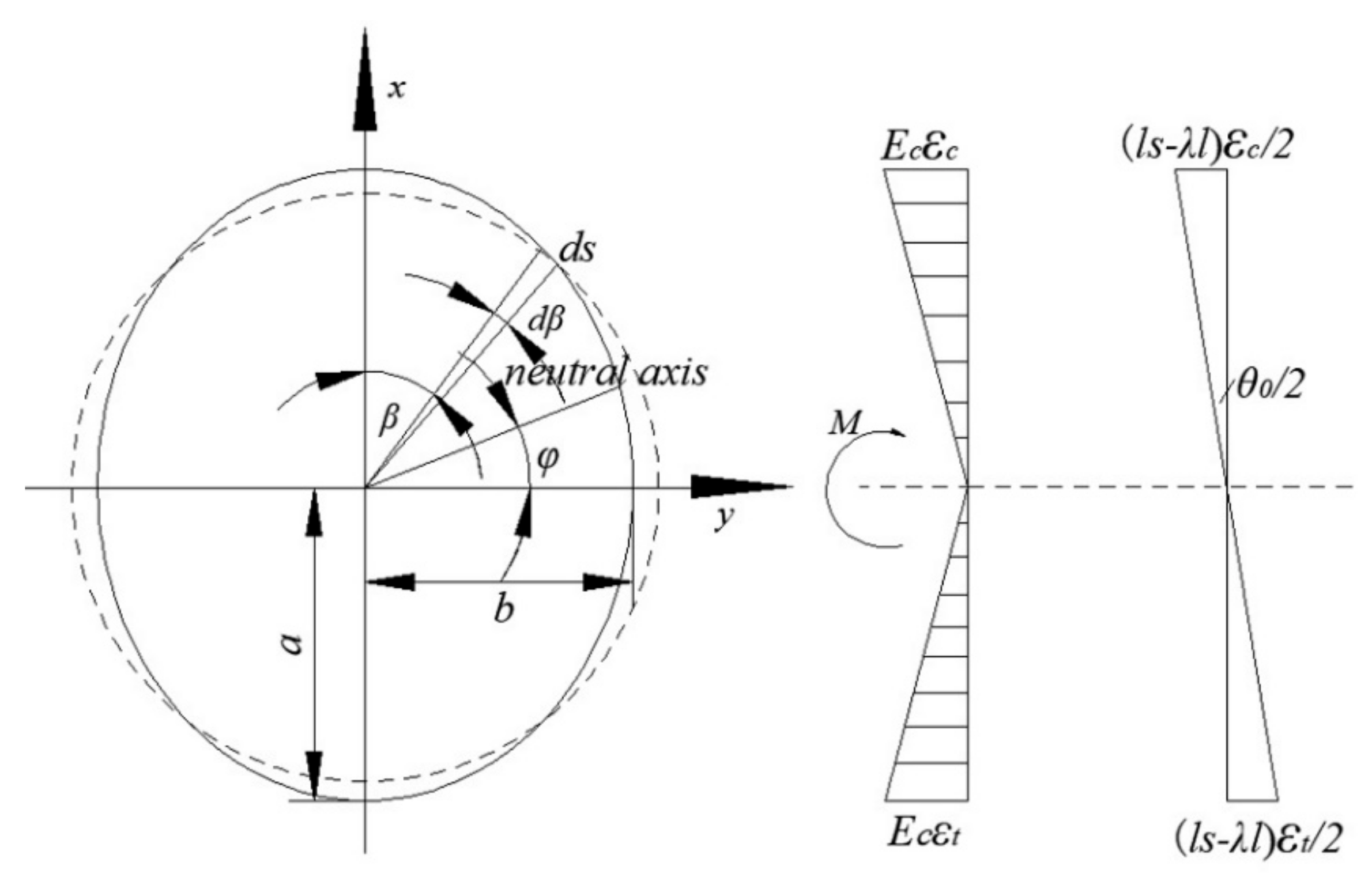
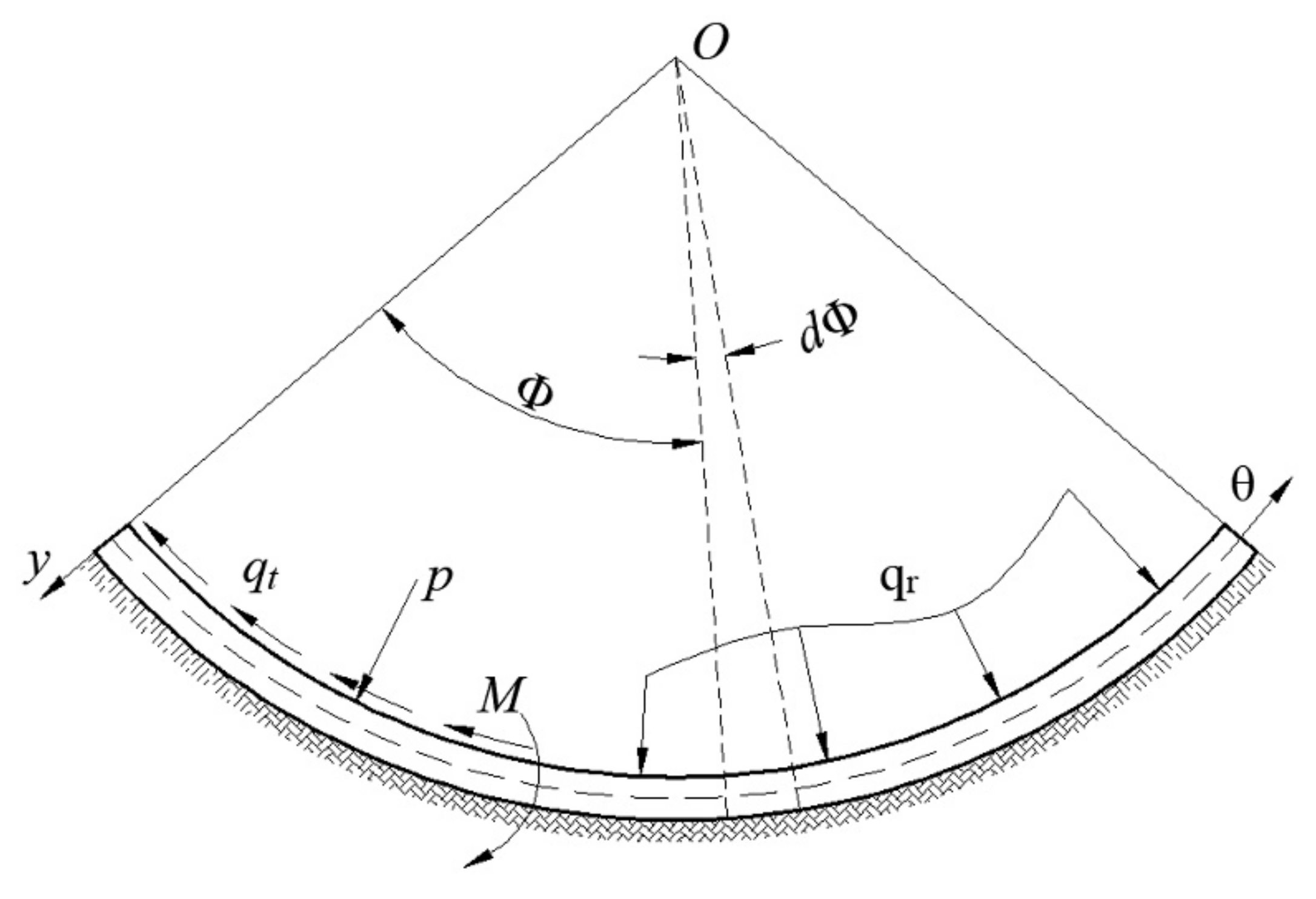

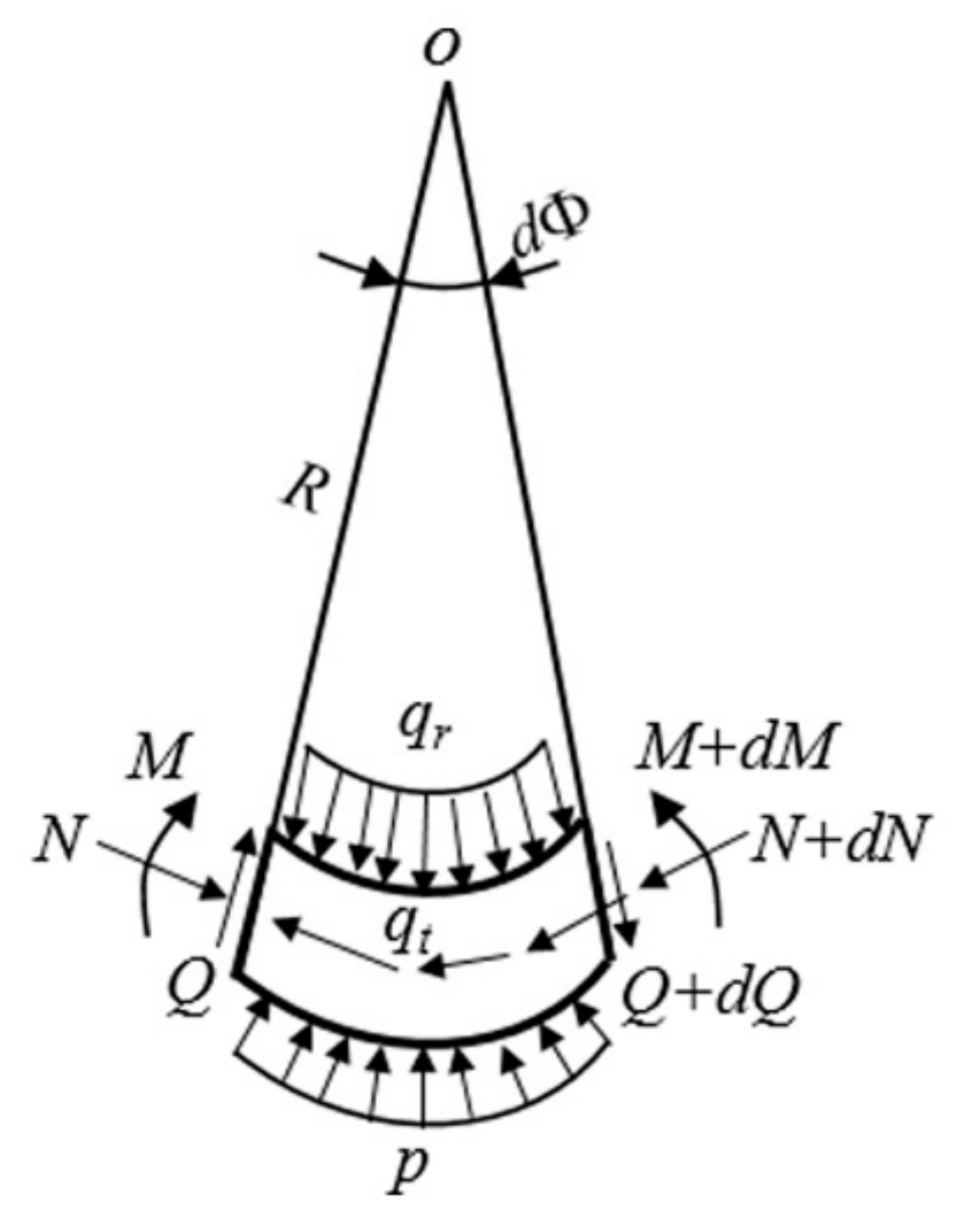

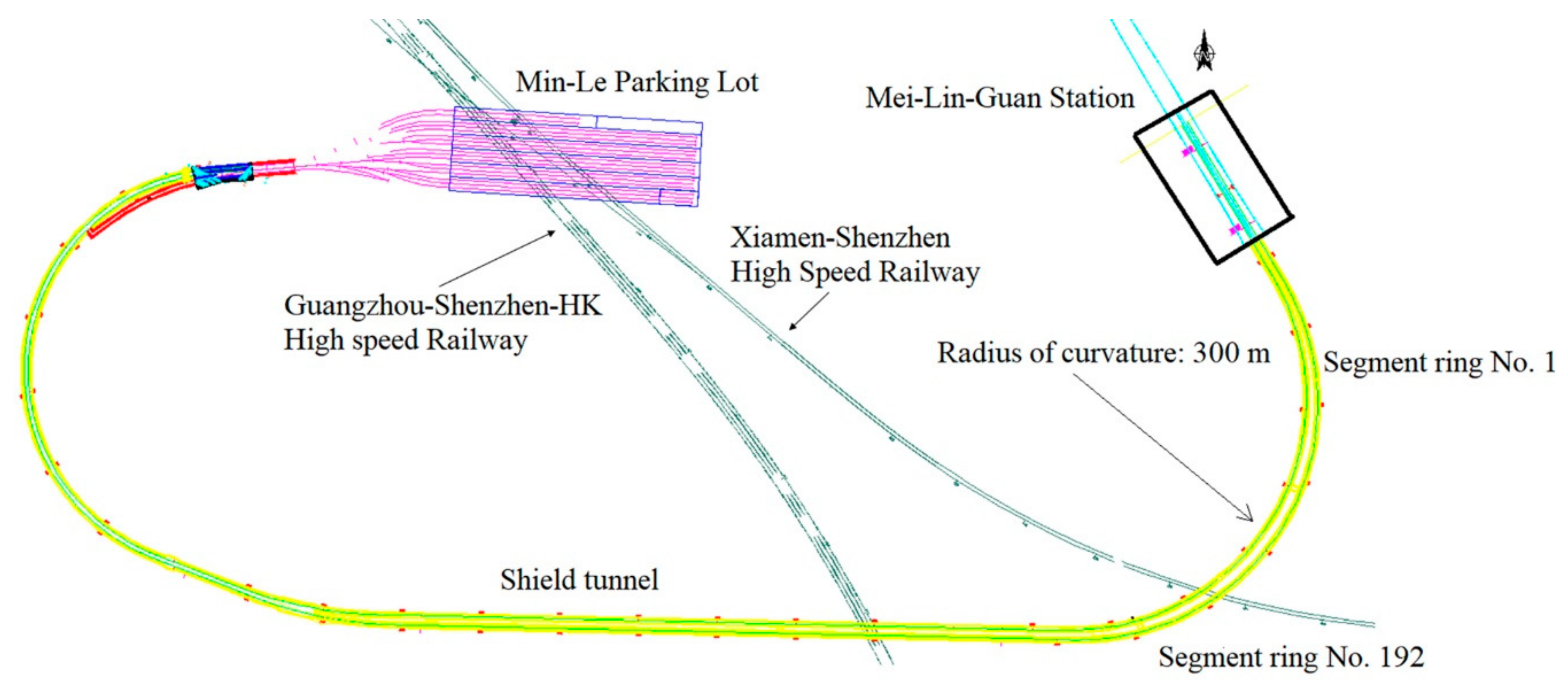
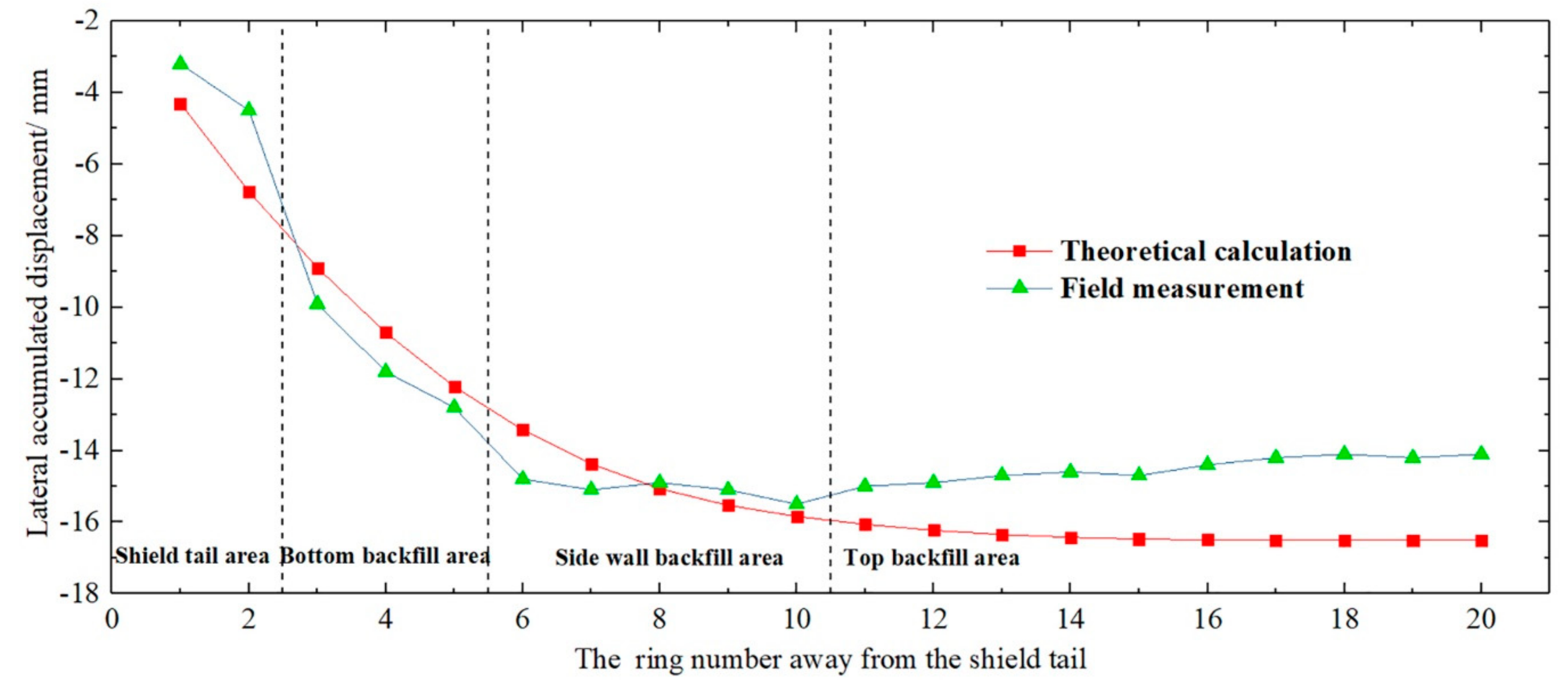

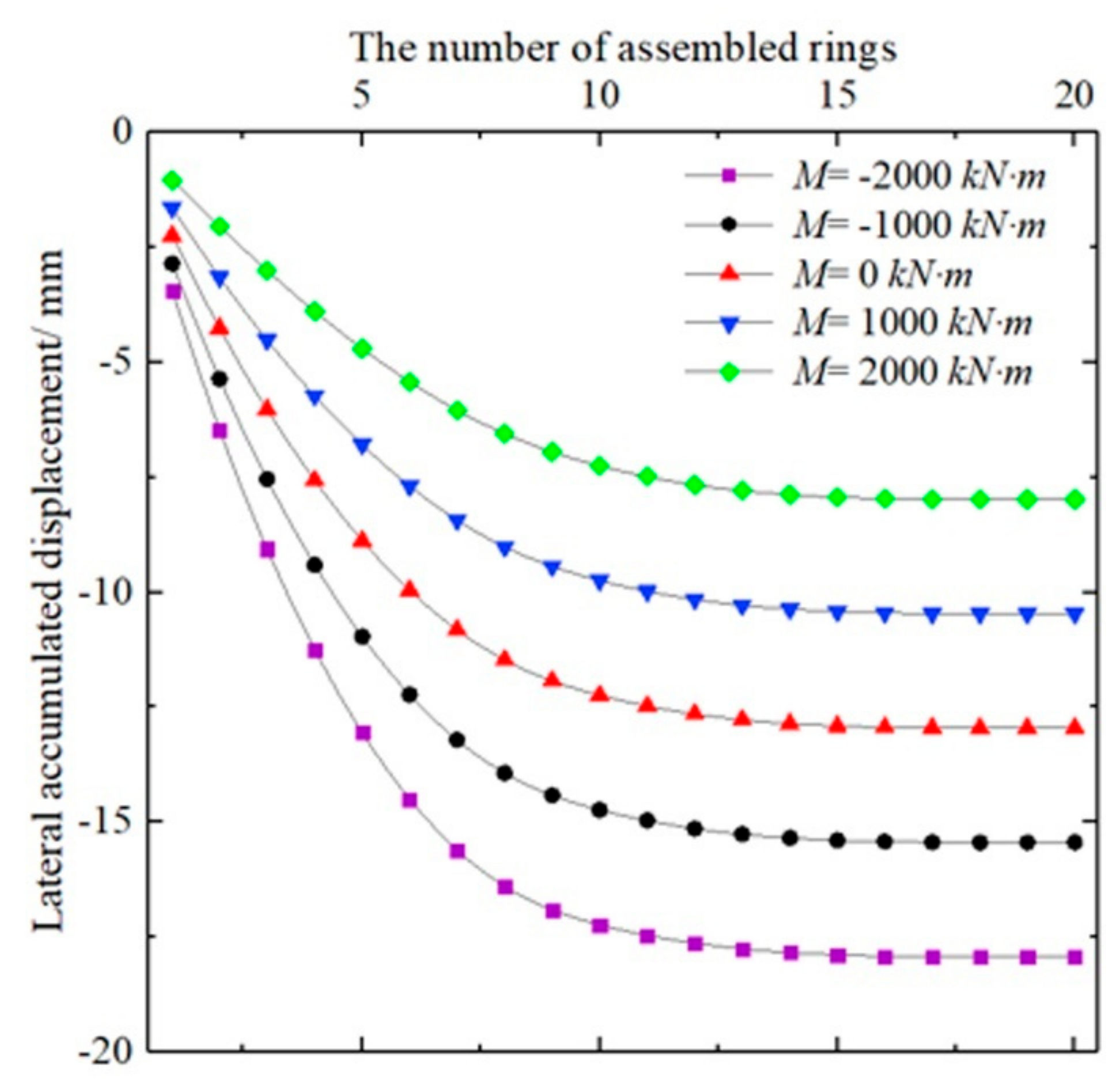

| Total Thrust F/(kN) | Lateral Force Couple M/(kN·m) | Deviation Angle α/(°) | Monitoring Data | ||
|---|---|---|---|---|---|
| N0/(kN) | M0/(kN·m) | Q0/(kN) | |||
| 5931.47 | −1708.20 | −0.390 | 5931.33 | −1708.20 | −40.36 |
| Total Thrust F/(kN) | Lateral Force Couple M/(kN·m) | Deviation Angle α/(°) | N0/(kN) | M0/(kN·m) | Q0/(kN) |
|---|---|---|---|---|---|
| 6000 | −1000 | −1 | 5999.09 | −1000 | −104.71 |
| 7000 | 6998.93 | −122.17 | |||
| 8000 | 7998.78 | −139.62 | |||
| 9000 | 8998.63 | −157.07 | |||
| 10,000 | 9998.48 | −174.52 |
| Total Thrust F/(kN) | Lateral Force Couple M/(kN·m) | Deviation Angle α/(°) | N0/(kN) | M0/(kN·m) | Q0/(kN) |
|---|---|---|---|---|---|
| 6000 | −2000 | −1 | 5999.09 | −2000 | −104.71 |
| −1000 | −1000 | ||||
| 0 | 0 | ||||
| 1000 | 1000 | ||||
| 2000 | 2000 |
| Total Thrust F/(kN) | Lateral Force Couple M/(kN·m) | Deviation Angle α/(°) | N0/(kN) | M0/(kN·m) | Q0/(kN) |
|---|---|---|---|---|---|
| 6000 | −1000 | −3 | 5991.78 | −1000 | −314.02 |
| −2 | 5996.34 | −209.40 | |||
| −1 | 5999.09 | −104.71 | |||
| 0 | 6000.00 | 0.00 | |||
| 1 | 5999.09 | 104.71 | |||
| 2 | 5996.34 | 209.40 | |||
| 3 | 5991.78 | 314.02 |
© 2020 by the authors. Licensee MDPI, Basel, Switzerland. This article is an open access article distributed under the terms and conditions of the Creative Commons Attribution (CC BY) license (http://creativecommons.org/licenses/by/4.0/).
Share and Cite
Qiao, S.; Xu, P.; Liu, R.; Wang, G. Study on the Horizontal Axis Deviation of a Small Radius TBM Tunnel Based on Winkler Foundation Model. Appl. Sci. 2020, 10, 784. https://doi.org/10.3390/app10030784
Qiao S, Xu P, Liu R, Wang G. Study on the Horizontal Axis Deviation of a Small Radius TBM Tunnel Based on Winkler Foundation Model. Applied Sciences. 2020; 10(3):784. https://doi.org/10.3390/app10030784
Chicago/Turabian StyleQiao, Shifan, Ping Xu, Ritong Liu, and Gang Wang. 2020. "Study on the Horizontal Axis Deviation of a Small Radius TBM Tunnel Based on Winkler Foundation Model" Applied Sciences 10, no. 3: 784. https://doi.org/10.3390/app10030784
APA StyleQiao, S., Xu, P., Liu, R., & Wang, G. (2020). Study on the Horizontal Axis Deviation of a Small Radius TBM Tunnel Based on Winkler Foundation Model. Applied Sciences, 10(3), 784. https://doi.org/10.3390/app10030784





